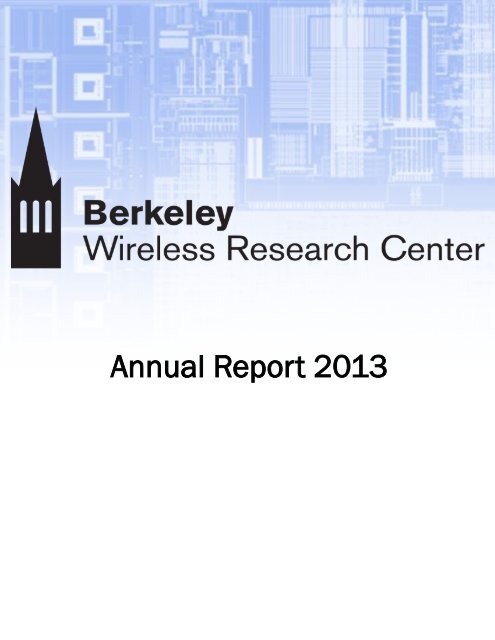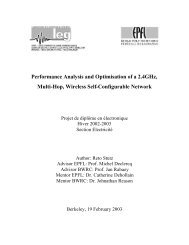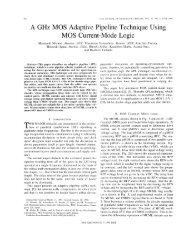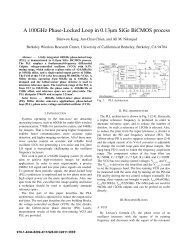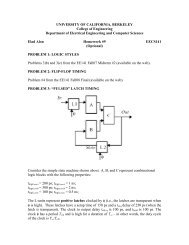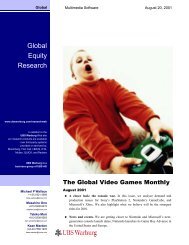here - Berkeley Wireless Research Center - University of California ...
here - Berkeley Wireless Research Center - University of California ...
here - Berkeley Wireless Research Center - University of California ...
Create successful ePaper yourself
Turn your PDF publications into a flip-book with our unique Google optimized e-Paper software.
Annual Report 2013
Table <strong>of</strong> Contents<br />
Introduction ................................................................................................................................ i<br />
BWRC Faculty & Scientific Directors...................................................................................... v<br />
Theme Reports<br />
RF and mm-Wave ................................................................................................................... 1<br />
Biomedical Systems .............................................................................................................. 21<br />
Energy Efficient Systems ....................................................................................................... 35<br />
Extreme Circuits .................................................................................................................... 55<br />
UnPad and eWallpaper......................................................................................................... 67<br />
Advanced Spectrum Utilization .............................................................................................. 77<br />
Integrated <strong>Wireless</strong> Systems and Applications ...................................................................... 85<br />
Recent Publications ................................................................................................................ 98<br />
Acknowledgements .............................................................................................................. 105<br />
BWRC Staff ............................................................................................................................ 109
BWRC Students<br />
Theme Reports<br />
RF and mm-Wave ...................................................................................................................................................... 1<br />
Ashkan Borna ................................................................................................................................................. 3<br />
Lucas Calderin ................................................................................................................................................ 4<br />
Jia-Shu Chen .................................................................................................................................................. 5<br />
Dajana Danilovic ............................................................................................................................................. 6<br />
Shinwon Kang .................................................................................................................................................. 7<br />
Lingkai Kong ................................................................................................................................................... 8<br />
Nai-Chung Kuo ................................................................................................................................................ 9<br />
Amanda Pratt ................................................................................................................................................ 10<br />
Paul Swirhun .................................................................................................................................................. 11<br />
Maryam Tabesh ............................................................................................................................................. 12<br />
Chintan Thakkar ........................................................................................................................................... 13<br />
Siva Thyagarajan ........................................................................................................................................... 14<br />
Andrew Townley ............................................................................................................................................ 15<br />
Angie Wang .................................................................................................................................................. 16<br />
Chaoying Wu ................................................................................................................................................ 17<br />
Bonjern Yang ................................................................................................................................................ 18<br />
Lu Ye ............................................................................................................................................................. 19<br />
Biomedical Systems................................................................................................................................................. 21<br />
William Biederman ......................................................................................................................................... 23<br />
Jun-Chau Chien ............................................................................................................................................. 24<br />
Ping-Chen Huang .......................................................................................................................................... 25<br />
Jaclyn Leverett .............................................................................................................................................. 26<br />
Wen Li ............................................................................................................................................................ 27<br />
Filip Maksimovic ........................................................................................................................................... 28<br />
Rikky Muller ................................................................................................................................................... 29<br />
Nathan Narevsky ........................................................................................................................................... 30<br />
DJ Seo ........................................................................................................................................................... 31<br />
Christopher Sutardja ...................................................................................................................................... 32<br />
Dan Yeager .................................................................................................................................................... 33<br />
Energy Efficient Systems ......................................................................................................................................... 35<br />
Steven Bailey ................................................................................................................................................ 37<br />
Jethro Beekman ............................................................................................................................................ 38<br />
Milovan Blagojevic ........................................................................................................................................ 39<br />
Pi-Feng Chiu .................................................................................................................................................. 40<br />
Ruzica Jevtic ................................................................................................................................................. 41<br />
Mervin John .................................................................................................................................................. 42<br />
Benjamin Keller ............................................................................................................................................. 43<br />
Nam-Seog Kim .............................................................................................................................................. 44<br />
Jaehwa Kwak ................................................................................................................................................. 45<br />
Hanh-Phuc Le ................................................................................................................................................ 46
Pengpeng Lu ................................................................................................................................................ 47<br />
Hoai Chau Nguyen Van ................................................................................................................................. 48<br />
Jesse Richmond ............................................................................................................................................ 49<br />
Nicholas Sutardja .......................................................................................................................................... 50<br />
Stephen Twigg ............................................................................................................................................... 51<br />
Wenting Zhou ................................................................................................................................................ 52<br />
Brian Zimmer ................................................................................................................................................. 53<br />
Extreme Circuits ...................................................................................................................................................... 55<br />
Steven Callender ........................................................................................................................................... 57<br />
John Crossley ................................................................................................................................................ 58<br />
Yida Duan ...................................................................................................................................................... 59<br />
Jaeduk Han .................................................................................................................................................... 60<br />
Rachel Hochman ........................................................................................................................................... 61<br />
Kwangmo Jung .............................................................................................................................................. 62<br />
Yue Lu ........................................................................................................................................................... 63<br />
Rachel Nancollas ........................................................................................................................................... 64<br />
Aikaterini Papadopoulou ................................................................................................................................ 65<br />
Matthew Spencer ........................................................................................................................................... 66<br />
UnPad and eWallpaper ........................................................................................................................................... 67<br />
Shaoyi Cheng ................................................................................................................................................ 69<br />
Terry Filiba ..................................................................................................................................................... 70<br />
Greg Gibeling ................................................................................................................................................. 71<br />
Alexander Krasnov ........................................................................................................................................ 72<br />
Hao Liu .......................................................................................................................................................... 73<br />
James Martin ................................................................................................................................................. 74<br />
Simon Scott ................................................................................................................................................... 75<br />
Advanced Spectrum Utilization ................................................................................................................................ 77<br />
Milos Jorgovanovic ........................................................................................................................................ 79<br />
Arash Parsa ................................................................................................................................................... 80<br />
Sameet Ramakrishnan .................................................................................................................................. 81<br />
Matthew Weiner ............................................................................................................................................. 82<br />
Sharon Xiao ................................................................................................................................................... 83<br />
Integrated <strong>Wireless</strong> Systems and Applications ........................................................................................................ 85<br />
Jayme Keist ................................................................................................................................................... 87<br />
Deepa Madan ................................................................................................................................................ 88<br />
Peter Minor .................................................................................................................................................... 89<br />
Christopher Sherman ..................................................................................................................................... 90<br />
Adam Tornheim ............................................................................................................................................. 91<br />
Jason Trager .................................................................................................................................................. 92<br />
Zuoqian Wang ............................................................................................................................................... 93<br />
Andrew Waterbury ......................................................................................................................................... 94<br />
Rich Winslow ................................................................................................................................................. 95<br />
Qiliang (Richard) Xu....................................................................................................................................... 96
INTRODUCTION<br />
Ken Lutz, Technical Director<br />
<strong>Berkeley</strong> <strong>Wireless</strong> <strong>Research</strong> <strong>Center</strong><br />
The <strong>Berkeley</strong> <strong>Wireless</strong> <strong>Research</strong> <strong>Center</strong> (BWRC), now in its second decade, is a partnership <strong>of</strong> UCB<br />
researchers, leading electronics companies, and government research agencies. The mission <strong>of</strong> BWRC is<br />
to educate world class researchers while exploring the leading edge <strong>of</strong> knowledge in future generations <strong>of</strong><br />
technology for wireless communications systems. BWRC addresses the design, conception, and<br />
implementation <strong>of</strong> the next-generation integrated wireless systems in state-<strong>of</strong>-the-art CMOS (and related)<br />
technologies. Our focus is on the integrated circuits and systems advances needed to enable a vision <strong>of</strong><br />
truly ubiquitous wireless, including the realization <strong>of</strong> always-connected reliable networks through<br />
advanced spectrum utilization techniques, the design <strong>of</strong> energy-efficient high data-rate links at 60 GHz<br />
and above, the investigation <strong>of</strong> the boundaries <strong>of</strong> ultra-low-energy wireless networks, and the exploration<br />
<strong>of</strong> the leading edge circuit techniques and components that make these systems possible.<br />
Faculty and students at BWRC collaborate in communication theory with the <strong>Berkeley</strong> <strong>Wireless</strong><br />
Foundations <strong>Center</strong>, in MEMS technology with the <strong>Berkeley</strong> Sensor and Actuator <strong>Center</strong> (BSAC), and in<br />
applications for biomedical and environmental engineering with the <strong>Center</strong> for Information Technology<br />
<strong>Research</strong> in the Interest <strong>of</strong> Society (CITRIS) and the UCSF Medical School. This critical-mass<br />
combination <strong>of</strong> UC <strong>Berkeley</strong> researchers, leading corporate sponsors and government funding agencies<br />
continues to deliver in making truly significant advances possible as demonstrated by the <strong>Center</strong>s’ impact<br />
in the areas <strong>of</strong> millimeter-wave radio, cognitive radio, ultra wideband and ultra-low power wireless<br />
systems.<br />
As you will see from this annual report, 2012 has been an exciting year at BWRC. Significant progress<br />
has been made across all areas <strong>of</strong> research and several new initiatives, including the eWallpaper, have<br />
moved forward.<br />
The following section provides a brief introduction and update to the seven research themes <strong>of</strong> the<br />
<strong>Berkeley</strong> <strong>Wireless</strong> <strong>Research</strong> <strong>Center</strong><br />
1. RF and mm-Wave<br />
The aim <strong>of</strong> this group is to design and implement highly-integrated RF and mm-wave transceivers using<br />
conventional silicon technology. The group consists <strong>of</strong> circuit designers who interact with system<br />
engineers to design energy efficient communication and imaging systems. Our current focus is on<br />
expanding the potential application space for low-cost mm-wave CMOS circuits and SoCs. Projects<br />
include high efficiency power amplifiers and transmitters, both for RF and mm-wave applications. These<br />
transmitters incorporate mixed signal and digital techniques to enhance the efficiency using an RF power<br />
DAC, oversampling and digital spectral image filtering. On the receiver side the focus is on improving<br />
the linearity <strong>of</strong> amplifiers and mixers to enable SAWless operation for multi-standard and reconfigurable<br />
front-ends. We are also exploring the application <strong>of</strong> mm-waves for wireless chip-to-chip communication.<br />
A 240 GHz prototype is developed to provide high data rates (> 10 Gbps) with low power consumption<br />
(< 50pJ/bit). Work in imaging includes the Time-domain UWB Synthetic Imager (TUSI) for medical<br />
applications and mm-Wave RFID.<br />
i
Operating at mm-wave frequencies using technologies with lossy substrates requires novel circuit design<br />
techniques as well as accurate high-frequency modeling <strong>of</strong> active and passive devices. Also, new system<br />
design methodologies will be needed to account for the limited performance <strong>of</strong> CMOS microwave circuits<br />
up to 300 GHz along with the huge amounts <strong>of</strong> available bandwidth. To accomplish this goal, our group<br />
combines <strong>Berkeley</strong>'s traditional expertise on integrated circuit design, device modeling, and system<br />
design with the state-<strong>of</strong>-the-art silicon technologies and vast experience with mm-wave circuit design<br />
provided by the BWRC industrial partners.<br />
2. Biomedical Systems<br />
Advancements in systems and circuits miniaturization and energy reduction allow for an ever-tighter<br />
interfacing between the biological and the cyber world. It is not too far-fetched to imagine integrated<br />
sensor (actuator) nodes, including data acquisition and processing circuitry as well as data transmission,<br />
that approach the size <strong>of</strong> a biological cell. This opens the door for a broad range <strong>of</strong> exciting new<br />
applications in the biomedical space. Examples include advanced in-situ and in-vivo monitoring and<br />
diagnostics, as well as stimulation or actuation. Mobility, longevity and reliability concerns demand that<br />
these nodes communicate wirelessly and operate in energy self-contained mode for a long period <strong>of</strong> time<br />
(> 10 years in some cases). The <strong>Berkeley</strong> <strong>Wireless</strong> <strong>Research</strong> <strong>Center</strong> (BWRC), with its long-established<br />
expertise in energy-efficient circuit design for processing and communication, as well as in energyharvesting<br />
technologies, is t<strong>here</strong>fore at the forefront <strong>of</strong> the development <strong>of</strong> the most advanced miniature<br />
biomedical systems. An example is its work in brain-machine interfaces (the ultimate unPad technology),<br />
in collaboration with the UCB-UCSF <strong>Center</strong> for Neural Engineering and Prosthetics (CNEP).<br />
<strong>Wireless</strong> technologies, besides <strong>of</strong>fering the capability <strong>of</strong> data communication and power delivery, also<br />
play an increasing role in medical imaging applications using the penetrating capabilities <strong>of</strong> highfrequency<br />
electromagnetic waveforms. BWRC has been a pioneer in the domain <strong>of</strong> millimeter-wave and<br />
TeraHertz transceivers, implemented in standard CMOS technologies. Advancing the state-<strong>of</strong>-the-art in<br />
CMOS electromagnetic imaging is the target <strong>of</strong> a range <strong>of</strong> projects at the <strong>Center</strong>, essential to the success<br />
<strong>of</strong> the tight integration <strong>of</strong> antennas, passives and active circuitry into single CMOS devices.<br />
3. Energy Efficient Systems<br />
<strong>Wireless</strong> systems are evolving to a three tiered environment with a ubiquitous, embedded and transparent<br />
sensory swarm at the outer layer. Ultra-low-power realizations <strong>of</strong> integrated wireless sensor nodes are an<br />
essential condition for the swarm concept to become truly successful. This research effort explores the<br />
boundaries <strong>of</strong> low-power design, seeking new design paradigms to enable both major power/energy<br />
reduction as well as continuing miniaturization. These reductions in size and energy can only be realized<br />
by a combination <strong>of</strong> innovative approaches, including novel technologies such as NEMS relays and<br />
oscillators; ultra-low-voltage scaled CMOS design; and alternative architectures for RF, mixed-signal and<br />
digital components.<br />
Energy scavenging and storage are critical enabling technologies for energy self-sufficient systems.<br />
<strong>Wireless</strong> power transmission and photovoltaic power harvesting are the most commonly explored<br />
techniques today, but other energy sources such as Vibrations, Air Flow, Temperature Gradients, Pressure<br />
Gradients and Human Power are being explored as well. For implantable devices, glucose bi<strong>of</strong>uel cells<br />
are an interesting option worth investigating.<br />
To push the limits, we have selected a number <strong>of</strong> advanced applications that would not be possible<br />
without major advances in low-power design technology. Among these are integrated bio-medical health<br />
management systems including sensors for neural implantation to enable brain-machine interfaces, energy<br />
self-contained sensor tags for body-area networking, wake-up radios, and sensor nets for smart energy<br />
systems.<br />
ii
4. Extreme Circuits<br />
Existing as well as evolving applications along with the integrated systems that enable them continue to<br />
require significant advances in their underlying circuit implementation. However, as CMOS scaling has<br />
shifted into a regime w<strong>here</strong> most <strong>of</strong> the device parameters do not significantly improve with<br />
miniaturization, realizing these circuit advances has become increasingly difficult to achieve. Our goal is<br />
thus to address these challenges by developing techniques that push the extremes <strong>of</strong> circuit performance,<br />
energy, and robustness, fueling the continued growth <strong>of</strong> IC applications.<br />
Given the many different functions integrated into modern ICs, researchers within this group focus on a<br />
variety <strong>of</strong> building blocks and their associated design methodologies, including digital computing and<br />
signal processing circuits, high-speed serial transceivers, RF components, memories, data converters,<br />
clock generation and synthesis circuits, and integrated voltage regulators. Furthermore, researchers are<br />
developing design methodologies and frameworks enabling the capture and automatic re-use (resulting in<br />
complete designs including schematics and layout) <strong>of</strong> the methodologies we have developed. In order to<br />
evaluate our techniques in the most realistic environment possible, many <strong>of</strong> the concepts developed<br />
within the group are demonstrated in some <strong>of</strong> the most advanced CMOS processes available (including<br />
45, 32 and 22nm FDSOI). To push the boundaries even further, our group is also exploring circuit designs<br />
exploiting the properties <strong>of</strong> next-generation and alternative switching devices such as FinFETs, spinbased<br />
transistors, and nano-mechanical relays.<br />
5. UnPad and eWallpaper<br />
The unPad is a vision <strong>of</strong> the future w<strong>here</strong> pads and other handheld devices cease to be necessary. The pad<br />
disappears, but its functionality (plus more) stays—in the form <strong>of</strong> unpackaged communication,<br />
computation, and storage. People seamlessly interact with data, the environment and one another through<br />
an interconnected set <strong>of</strong> sensor, actuators, and computing and storage devices. Sensors and actuators in<br />
the environment are used as input/output devices, and along with computing, storage, and communication<br />
bandwidth, will be commissioned on the fly as needed to provide the desired functionality. As a person<br />
moves through their environment, say from home to car and then to their <strong>of</strong>fice, a set <strong>of</strong> their data moves<br />
with them, and the sensors and actuators in whatever environment they happen to occupy are clustered in<br />
an ad hoc way to support whatever services are currently needed. This strong sense <strong>of</strong> seamless mobility,<br />
and the opportunistic assembly and allocation <strong>of</strong> resources is what has been missing in earlier similar<br />
visions such as ubiquitous computing. Our research at BWRC forms the basis <strong>of</strong> what is needed to fulfill<br />
the unPad vision.<br />
The unPad vision presents many technical challenges. We envision an infrastructure that dynamically<br />
matches the needs <strong>of</strong> the user to available resources, thus creating a “virtual device”. Such a vision is a<br />
significant deviation from current wireless systems networking in terms <strong>of</strong> data streaming and control.<br />
Discovery plays a key role, as does the need to continuously bundle local functionality in creating<br />
services. The infrastructure must exploit locality to maximize total system communication capacity and<br />
minimize energy consumption. The dynamic configuration requires sophisticated resource management<br />
and policies for conflict resolution. We envision a hierarchical wireless region-based model: from the<br />
human-body level, to the room, to the building, to an entire block, etc. However, this clustering would be<br />
dynamically changing, as a person's spatial domain <strong>of</strong> interest changes. In some cases the domains will<br />
be “virtual” instead <strong>of</strong> physical, to handle long-distance communication modes such as tele-presence.<br />
Peer-to-peer connections within zone (similar to WiFi Direct or FlashLinq) will be used. Whenever<br />
present, the fixed wired infrastructure can be a complement to wireless.<br />
iii
6. Advanced Spectrum Utilization<br />
The goal <strong>of</strong> this group is to fundamentally change the operation <strong>of</strong> wireless communication systems.<br />
Explosive growth <strong>of</strong> wireless communications over the last decade and reliance on mobile telephones for<br />
daily voice and data communication, and <strong>of</strong>ten for first contact in case <strong>of</strong> emergency, has become<br />
pervasive. Present methods <strong>of</strong> frequency allocation combined with a reliance on rigid infrastructure<br />
threaten to halt this growth. By enabling secondary use <strong>of</strong> spectrum on an opportunistic basis, ubiquitous,<br />
robust and agile wireless systems can be realized that are able to support further traffic growth. As such, it<br />
will enable the extension <strong>of</strong> wireless data-rates and coverage for many decades to come and open the door<br />
for exciting new applications to emerge.<br />
This set <strong>of</strong> projects will lay the theoretical foundation, develop the necessary systems knowledge and<br />
demonstrate prototype test beds for a new kind <strong>of</strong> a wireless system, which will operate in a very broad<br />
frequency spectrum with bands <strong>of</strong> operation that can be dynamically allocated. Additionally, this group<br />
will investigate methods for optimal use <strong>of</strong> spatial diversity to enable continued capacity growth <strong>of</strong><br />
wireless systems by operating at the limits <strong>of</strong> available multiplexing and diversity gains. One <strong>of</strong> the<br />
concepts that would enable the reuse <strong>of</strong> frequency bands is a Connectivity Broker—an agent embedded in<br />
the wireless infrastructure that communicates over a virtual control channel—to support diversity <strong>of</strong> radio<br />
technologies as well as innovative rules <strong>of</strong> cooperation. The concept <strong>of</strong> secondary use <strong>of</strong> the spectrum in<br />
combination with advanced cooperation between system components is revolutionary, and it is enabled by<br />
advances in fundamental communications and networking theory and continued improvements in<br />
integrated circuit technology.<br />
7. Integrated <strong>Wireless</strong> Systems and Applications<br />
High-value products such as aerospace engines and semiconductor fabrication equipment will continue to<br />
expand in sophistication and include even more sensing and closed-loop control. The trend towards the<br />
deployment <strong>of</strong> wireless sensor nodes and networks (WSNs) will continue due to lower cost and flexibility<br />
<strong>of</strong> such systems. As a result, the many sub-assemblies <strong>of</strong> these high-value products will be densely<br />
packed with wireless sensor nodes for the purpose <strong>of</strong> fine-grained monitoring over the whole lifetime <strong>of</strong><br />
the product. Even modestly complex products such as the pumps and motors in the cooling/air cleaning<br />
systems <strong>of</strong> a semiconductor fab need better monitoring than is common today. Better monitoring and<br />
sustainment efforts can be achieved with condition–based monitoring platforms that combine energy<br />
harvesting, energy storage, sensors, and wireless communication. Condition monitoring research extends<br />
beyond industrial machinery and currently includes societal infrastructure associated with the smart grid,<br />
water, and gas pipelines. To enable this research, an adaptable wireless node architecture has been<br />
developed around the Texas Instruments eZ430-RF2500 wireless development platform. The node can be<br />
configured to accept harvested energy from the in<strong>here</strong>nt mechanical vibrations <strong>of</strong> industrial machinery,<br />
AC energized conductors, or a battery. The standard node configuration includes a digital accelerometer<br />
and pressure sensor, but it can accept additional sensor inputs as well. Independent research continues on<br />
energy harvesting, energy storage, sensors (current, voltage, pressure), and condition monitoring, but each<br />
research component can be combined, tested, and realistically deployed using the adaptable node<br />
architecture based on the TI eZ430-RF2500 wireless development platform. These research condition<br />
monitoring nodes combining the various technologies are currently being deployed on industrial<br />
machinery and gas pipelines to collect data that will enable mapping <strong>of</strong> the unique signatures <strong>of</strong> specific<br />
machine or infrastructure failures.<br />
iv
BWRC FACULTY & SCIENTIFIC DIRECTORS<br />
Elad Alon<br />
Associate Pr<strong>of</strong>essor <strong>of</strong> Electrical Engineering and Computer<br />
Sciences<br />
E-mail: elad@berkeley.edu<br />
<strong>Research</strong> Web Page: http://www.eecs.berkeley.edu/~elad<br />
Pr<strong>of</strong>essor Alon received the B.S., M.S., and Ph.D. degrees in<br />
Electrical Engineering from Stanford <strong>University</strong>. He joined the<br />
faculty at the <strong>University</strong> <strong>of</strong> <strong>California</strong>, <strong>Berkeley</strong> in January 2007.<br />
He has held visiting positions at Cadence, Xilinx, Oracle Labs,<br />
Intel, AMD, Rambus, HP, and IBM, w<strong>here</strong> he worked on digital,<br />
analog, and mixed-signal integrated circuits for computing, test and<br />
measurement, and high-speed communications. His research<br />
interests are in energy-efficient integrated systems, including the<br />
circuit, device, and optimization techniques used to design them.<br />
Bob Brodersen<br />
Pr<strong>of</strong>essor Emeritus <strong>of</strong> Electrical Engineering and Computer<br />
Sciences<br />
E-mail: rb@eecs.berkeley.edu<br />
<strong>Research</strong> Web Page:<br />
http://bwrc.eecs.berkeley.edu/People/Faculty/rb/<br />
A pioneer in the field <strong>of</strong> computer speech recognition and a leading<br />
authority in wireless communication. Pr<strong>of</strong>essor Brodersen received<br />
his Ph.D. from MIT in 1976 and was associated with the Central<br />
<strong>Research</strong> Laboratory, Texas Instruments until 1976, when he<br />
joined the EECS faculty at the <strong>University</strong> <strong>of</strong> <strong>California</strong>, <strong>Berkeley</strong>.<br />
A member <strong>of</strong> the National Academy <strong>of</strong> Engineering, his research<br />
interests include communication systems, signal processing and<br />
design, layout, simulation, and testing <strong>of</strong> integrated circuits.<br />
v
Ali M. Niknejad<br />
Pr<strong>of</strong>essor <strong>of</strong> Electrical Engineering and Computer Sciences<br />
E-mail: niknejad@eecs.berkeley.edu<br />
<strong>Research</strong> Web Page: http://rfic.eecs.berkeley.edu/~niknejad/<br />
Pr<strong>of</strong>essor Ali M. Niknejad received the B.S.E.E. degree from the<br />
<strong>University</strong> <strong>of</strong> <strong>California</strong>, Los Angeles, in 1994, and his Master’s<br />
and Ph.D. degrees in electrical engineering from the <strong>University</strong> <strong>of</strong><br />
<strong>California</strong>, <strong>Berkeley</strong>, in 1997 and 2000. He is currently a pr<strong>of</strong>essor<br />
in the EECS department at UC <strong>Berkeley</strong> and co-director <strong>of</strong> the<br />
<strong>Berkeley</strong> <strong>Wireless</strong> <strong>Research</strong> <strong>Center</strong> and the BSIM <strong>Research</strong><br />
Group. His research interests lie within the area <strong>of</strong> RF, mm-wave,<br />
and sub-THz for applications in medicine and wireless<br />
communications. Pr<strong>of</strong>. Niknejad is an IEEE Fellow and recipient<br />
<strong>of</strong> the 2012 ASEE Frederick Emmons Terman Award.<br />
Borivoje Nikolić<br />
Pr<strong>of</strong>essor <strong>of</strong> Electrical Engineering and Computer Sciences<br />
E-mail: bora@eecs.berkeley.edu<br />
<strong>Research</strong> Web Page: http://www.eecs.berkeley.edu/~bora/<br />
Pr<strong>of</strong>essor Nikolić has main interests in the implementation <strong>of</strong><br />
communications circuits and systems. He received his Dipl. Ing<br />
and M.Sc. degrees in Electrical Engineering from the <strong>University</strong> <strong>of</strong><br />
Belgrade, Yugoslavia in 1992 and 1994, respectively. He received<br />
a Ph.D. degree in Electrical and Computer Engineering from the<br />
<strong>University</strong> <strong>of</strong> <strong>California</strong>, Davis in 1999. Before coming to<br />
<strong>Berkeley</strong>, he had appointments as a lecturer at the <strong>University</strong> <strong>of</strong><br />
Belgrade and with Silicon Systems, Inc., Texas Instruments<br />
Storage Products Group, San Jose, CA, w<strong>here</strong> he worked on disk<br />
drive signal processing electronics.<br />
vi
Jan Rabaey<br />
Donald O. Pederson Distinguished Pr<strong>of</strong>essor<br />
<strong>of</strong> Electrical Engineering and Computer Sciences<br />
Director <strong>of</strong> Multiscale Systems <strong>Center</strong> (MuSyC)<br />
E-mail: jan@eecs.berkeley.edu<br />
<strong>Research</strong> Web Page:<br />
http://bwrc.eecs.berkeley.edu/People/Faculty/jan/<br />
Pr<strong>of</strong>essor Rabaey is a leader in the domains <strong>of</strong> low power design<br />
technologies and methodologies. After receiving his Ph.D. degree<br />
in Applied Sciences from the Katholieke Universiteit Leuven,<br />
Belgium in 1983, he joined the <strong>University</strong> <strong>of</strong> <strong>California</strong>, <strong>Berkeley</strong><br />
as a Visiting <strong>Research</strong> Engineer. From 1985 to1987 he was a<br />
research manager at IMEC, Belgium, and in 1987 he joined the<br />
faculty <strong>of</strong> the Electrical Engineering and Computer Science<br />
department <strong>of</strong> the <strong>University</strong> <strong>of</strong> <strong>California</strong>, <strong>Berkeley</strong>. From 1999<br />
until 2002, he was the Associate Chair <strong>of</strong> the EECS department at<br />
UC <strong>Berkeley</strong>. He is the past director <strong>of</strong> the FCRP Gigascale<br />
Systems <strong>Research</strong> <strong>Center</strong> (GSRC) and the current director <strong>of</strong> the<br />
FCRP Multiscale Systems <strong>Center</strong> (MuSyC). An IEEE Fellow and<br />
recipient <strong>of</strong> the 2008 IEEE CAS Mac Van Valkenburg, the 2009<br />
EDAA Lifetime Achievement and the 2010 Semiconductor<br />
Industry Association <strong>University</strong> <strong>Research</strong>er Awards, his current<br />
research interests include the conception and design <strong>of</strong> nextgeneration<br />
wireless systems with a special focus on ubiquitous<br />
distributed systems.<br />
vii
John Wawrzynek<br />
Pr<strong>of</strong>essor <strong>of</strong> Electrical Engineering and Computer Sciences<br />
E-mail: johnw@eecs.berkeley.edu<br />
<strong>Research</strong> Web Page: http://www.cs.berkeley.edu/~johnw/<br />
Dr. John Wawrzynek is a Pr<strong>of</strong>essor <strong>of</strong> Electrical Engineering and<br />
Computer Sciences at the <strong>University</strong> <strong>of</strong> <strong>California</strong>, <strong>Berkeley</strong>. He<br />
holds a Ph.D. and M.S. in Computer Science from the <strong>California</strong><br />
Institute <strong>of</strong> Technology, an M.S. in Electrical Engineering from the<br />
<strong>University</strong> <strong>of</strong> Illinois, Urbana/Champaign, and a BS in Electrical<br />
Engineering, from the State <strong>University</strong> <strong>of</strong> New York at Buffalo. He<br />
is a Faculty Scientist at Lawrence <strong>Berkeley</strong> National Laboratory,<br />
NERSC Division and a co-director at the <strong>Berkeley</strong> <strong>Wireless</strong><br />
<strong>Research</strong> <strong>Center</strong> (BWRC). His research projects include<br />
reconfigurable computing and computer architecture. He formed<br />
the <strong>Berkeley</strong> Reconfigurable Computing group and pioneered<br />
hardware architectures and programming models for hybrid systems<br />
combining reconfigurable arrays with conventional processors<br />
cores. He was principle investigator <strong>of</strong> the <strong>Research</strong> Accelerator for<br />
Multiple Processors (RAMP) project that developed FPGAs-based<br />
simulation systems for computer architecture research. He is<br />
currently PI <strong>of</strong> the <strong>Berkeley</strong> ISIS project addressing the need for<br />
rapid design space exploration and hardware/s<strong>of</strong>tware co-design for<br />
energy efficient many-core system development which is part <strong>of</strong> an<br />
interdisciplinary team on the application <strong>of</strong> FPGA computing<br />
technology to problems in systems biology. He currently teaches<br />
courses in digital design, computer architecture, VLSI system<br />
design, and reconfigurable computing. He was co-founder <strong>of</strong> Andes<br />
Networks, a company specializing in the design and manufacturing<br />
<strong>of</strong> accelerators for network security, and BEECube, Inc.,<br />
specializing in reconfigurable computing systems.<br />
viii
Paul K. Wright<br />
Pr<strong>of</strong>essor<br />
A. Martin Berlin Chair in Mechanical Engineering<br />
E-mail: pwright@bwrc.eecs.berkeley.edu<br />
<strong>Research</strong> Web Page: http://www.me.berkeley.edu/faculty/wright/<br />
Paul K. Wright is the Director for <strong>Center</strong> for Information<br />
Technology in the Interest <strong>of</strong> Society (CITRIS) at UC <strong>Berkeley</strong>. It<br />
serves four <strong>University</strong> <strong>of</strong> <strong>California</strong> campuses and hosts many<br />
multi-disciplinary projects on large societal problems, including<br />
healthcare, services and intelligent infrastructures such as energy,<br />
water and sustainability. Pr<strong>of</strong>essor Wright teaches in the<br />
Mechanical Engineering department, w<strong>here</strong> he holds the A. Martin<br />
Berlin Chair. He also serves as co-director <strong>of</strong> the <strong>Berkeley</strong><br />
Manufacturing Institute (BMI) and co-director <strong>of</strong> the <strong>Berkeley</strong><br />
<strong>Wireless</strong> <strong>Research</strong> <strong>Center</strong> (BWRC). From 1995 to 2005 he served<br />
as co-chair <strong>of</strong> the Management <strong>of</strong> Technology Program (a joint<br />
program with the Haas School <strong>of</strong> Business). His research and<br />
teaching are in high-tech product design and rapid manufacturing.<br />
Currently, he and his colleagues are designing and prototyping<br />
wireless systems for "Demand Response Power Management"<br />
throughout <strong>California</strong>, funded by PIER/CEC (the Public Interest<br />
Energy <strong>Research</strong> program <strong>of</strong> the <strong>California</strong> Energy Commission).<br />
Born in London, England, he attended Birmingham and Cambridge<br />
universities prior to attaining previous U.S. faculty positions at New<br />
York <strong>University</strong> and Carnegie Mellon <strong>University</strong>.<br />
ix


